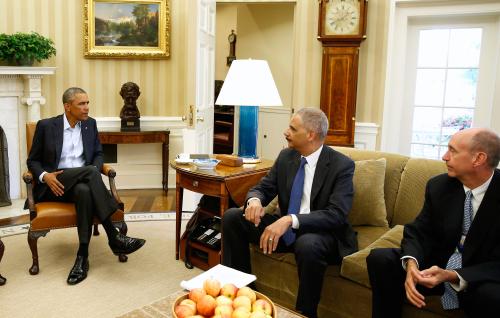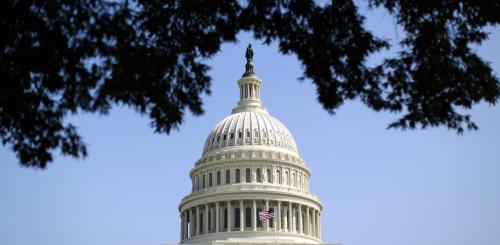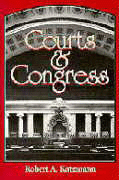Judicial confirmations have moved at a snail’s pace since Senate control changed hands in January 2015. The majority’s justification is that, overall, the Senate has confirmed more Obama nominees than it had President Bush’s at the same point in his presidency: Majority Leader McConnell in April: “No effort to redefine what this is about will be successful. The issue before the Senate is: Has President Obama been treated fairly with regard to the confirmation of judges during his tenure in office? We are to a point where we know that so far during the Obama years he’s gotten 23 more judges than President Bush got to this point.”
I explained last month how this curious view of the Senate’s advice and consent function misstates who deserves “fair” treatment: not presidents, as McConnell contends, but rather the litigants and sitting judges who must cope with vacant judgeships.
Brookings’s Democracy Dashboard
Judicial vacancies reflect performance by the executive and judicial branches. They also measure an aspect of judicial branch capacity. Case filing and termination data paint other aspects of that picture. The Brookings Democracy Dashboard recently rolled out a second round of data focused on the institutional capacity of the government and the media, including a section with some national indicators of judicial branch performance and capacity. These indicators are drawn from data published regularly by the Administrative Office of the U.S. Courts, an essential resource for understanding the work of the federal courts.
Current vacancy-related performance
The data in this short post come the Administrative Office, the Federal Judicial Center, and my own data collections. They demonstrate the feebleness of the current Senate’s vacancy-related performance compared to Senates during recent two-term president’s final two years, as of June 1 of the eighth year. Then, as now, the White House and the Senate were controlled by different parties.
The table shows that on June 1, 1988—during President Reagan’s final year in office—there were 31 district court vacancies, 24 percent fewer than in January 1987. The Senate had confirmed, all told, 276 district judges, 23 percent of them since January 1987. The confirmation rate for nominees submitted or resubmitted since January 1987 was 72 percent. These figures varied slightly during Presidents Clinton’s and Bush’s final quarters. Vacancies rose or fell modestly; a bit less than a fifth of all district confirmations occurred during those 17 months; and confirmation rates were in the 60 to 70 percent range.
By contrast, during the final Obama quarter, vacancies have skyrocketed by 112 percent; confirmations are only six percent higher than they were in January 2015; and the 27 percent confirmation rate is less than half of those in the three earlier final quarters.
 Previous Senates held vacancies in check with comparatively robust confirmation rates but also because judges created fewer vacancies. Almost all judges leave active status, thus creating vacancies, by
Previous Senates held vacancies in check with comparatively robust confirmation rates but also because judges created fewer vacancies. Almost all judges leave active status, thus creating vacancies, by
taking senior status
, a form of semi-retirement during which most continue to hear cases, although usually not carrying a full workload. Under Obama’s recent two-term predecessors, up to June 1 of the eighth year, 142, 192, and 165 district judges took senior status. So far under Obama, 240 have.
Fewer judges took senior status under Bush, and he submitted fewer nominations—266 at this point, versus 321 by Obama. The Senate has not responded to this changing district court landscape, despite 44 pending nominees, 21 of whom have had Judiciary Committee hearings; Most, but not all, of these nominees are non-controversial, with, where applicable, the support of home-state Republican senators.
The comparable figures for the courts of appeals are less striking, but the uptick in vacancies is higher than in the three previous quarters, and the two circuit judges confirmed since January 2015 represent the smallest increase of the four final quarters. Part of the difference is that the large increase in senior status district judges during Obama’s term were not matched by circuit judges—41 under Obama, versus 37 under Bush, but larger numbers, 47 and 52, under Reagan and Clinton.











Commentary
Is a 112 percent increase in judicial vacancies par for the course?
June 6, 2016